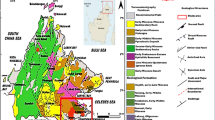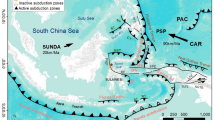Abstract
We present a fine-scale shallow geological setting and its possible influence on the seismic building behaviour of L’Aquila downtown which suffered many casualties and building damage caused by the 6 April 2009, Mw 6.1 earthquake. This study draws mainly on the integration of 666 borehole logs and 274 microtremor recordings interpolated with GIS-based techniques. The shallow geology of L’Aquila downtown is characterised by Middle Pleistocene calcareous L’Aquila breccias. Their top surface consists of a weathered epikarst zone that is mantled by Red Soil (reddish colluviated Alfisols) formed during the late Pleistocene. The areal distribution and thickness of Red Soil are causative of the medium microtremor frequency (3–13 Hz). The map of cross-correlation between the medium frequencies, estimated through the empirical Eurocode 8 equation, shows buildings with possible seismic coupling due to the shallow geology setting and the fundamental building period. This technique is further supported by the areal distribution of seismic building damages caused by the 2009 and 1703 L’Aquila earthquakes. This approach, carried out with a large geological and geophysical dataset, is useful in defining seismic site effects and may be effective in mitigating the seismic risk of cities with notable historical heritage in Central Italy, such as the L’Aquila downtown area.












Similar content being viewed by others
References
Agostini S, Palombo MR, Rossi MA et al (2012) Mammuthus meridionalis (Nesti, 1825) from Campo di Pile (L’Aquila, Abruzzo, Central Italy). Quat Int 276:42–52
Boncio P, Lavecchia G, Pace B (2004) Defining a model of 3D seismogenic sources for seismic hazard assessment applications: the case of central Apennines (Italy). J Seismol 8:407–425
Bosi C, Galadini F, Giaccio B et al (2003) Plio-Quaternary continental deposits in the Latium-Abruzzi Apennines: the correlation of geological events across different intermontane basins. Quat 16:55–76
Cavinato GP, De Celles PG (1999) Extensional basins in the tectonically bimodal central Apennines fold-thrust belt, Italy: response to corner flow above a subducting slab in retrograde motion. Geology 27:955–958
Cavinato GP, Carusi C, Dall’asta M et al (2002) Sedimentary and tectonic evolution of Plio-Pleistocene alluvial and lacustrine deposits of Fucino Basin (central Italy). Sediment Geol 148:29–59. https://doi.org/10.1016/S0037-0738(01)00209-3
Centamore E, Crescenti U, Dramis F, et al (2006) Note illustrative della Carta Geologica d’Italia alla scala 1: 50.000, Foglio 359 l’Aquila. Serv Geol d’Italia-Apat 128
Colapietra R (1978) L’Aquila dell’Antinori strutture sociali ed urbane della citta’nel sei e settecento. Nella Sede della Deputazione
Coltorti M, Pieruccini P (2006) The last interglacial pedocomplexes in the litho- and morpho-stratigraphical framework of the central-northern Apennines (Central Italy). Quat Int 156–157:118–132. https://doi.org/10.1016/j.quaint.2006.05.025
Cosentino D, Asti R, Nocentini M et al (2017) New insights into the onset and evolution of the central Apennine extensional intermontane basins based on the tectonically active L’Aquila Basin (central Italy). Bull Geol Soc Am 129:1314–1336. https://doi.org/10.1130/B31679.1
Del Monaco F, Tallini M, De Rose C, Durante F (2013) HVNSR survey in historical downtown L’Aquila (central Italy): site resonance properties vs. subsoil model. Eng Geol 158:34–47. https://doi.org/10.1016/j.enggeo.2013.03.008
Di Giulio G, Gaudiosi I, Cara F et al (2014) Shear-wave velocity profile and seismic input derived from ambient vibration array measurements: the case study of downtown L’Aquila. Geophys J Int 198:848–866. https://doi.org/10.1093/gji/ggu162
Eurocode CEN (2004) Eurocode 8: design of structures for earthquake resistance. Part 1:1991–1998
Ford DC, Williams PW (1989) Karst geomorphology and hydrology. Unwin Hyman, London
Galli P, Giaccio B, Messina P (2010) The 2009 central Italy earthquake seen through 0.5 Myr-long tectonic history of the L’Aquila faults system. Quat Sci Rev 29:3768–3789
Giaccio B, Galli P, Messina P et al (2012) Fault and basin depocentre migration over the last 2 Ma in the L’Aquila 2009 earthquake region, central Italian Apennines. Quat Sci Rev 56:69–88
Gosar A, Lenart A (2010) Mapping the thickness of sediments in the Ljubljana Moor basin (Slovenia) using microtremors. Bull Earthq Eng 8:501–518
Grünthal G (1998) European macroseismic scale 1998. European Seismological Commission, Luxembourg
Gunn J (2004) Encyclopedia of caves and karst science. Taylor & Francis
Gutiérrez F, Parise M, De Waele J, Jourde H (2014) A review on natural and human-induced geohazards and impacts in karst. Earth Sci Rev 138:61–88
Hailemikael S, Lenti L, Martino S et al (2016) Ground-motion amplification at the Colle di Roio ridge, central Italy: a combined effect of stratigraphy and topography. Geophys J Int 206:1–18
Hughes PD, Woodward JC, Gibbard PL et al (2006) The glacial history of the Pindus Mountains, Greece. J Geol 114:413–434
Lorè A, Magaldi D (2015) Limi rossi del sottosuolo dell’Aquila: un’indagine geologica, geotecnica e micromorfologica. Geol Tec Ambient 1:11–32
Lore A, Magaldi D, Tallini M (2002) Morphology and morphometry of the Gran Sasso (Central Italy) surface karst. Geogr Fis Din Quat 25:123–134
Magaldi D, Tallini M (2000) A micromorphological index of soil development for the Quaternary geology research. Catena 41:261–276. https://doi.org/10.1016/S0341-8162(00)00096-5
Mancini M, Cavuoto G, Pandolfi L et al (2012) Coupling basin infill history and mammal biochronology in a Pleistocene intramontane basin: the case of western L’Aquila Basin (central Apennines, Italy). Quat Int 267:62–77
Martelli L, Boncio P, Baglione M et al (2012) Main geologic factors controlling site response during the 2009 L’Aquila earthquake. Ital J Geosci 131:423–439. https://doi.org/10.3301/IJG.2012.12
MS-AQ Working Group (2010) Microzonazione sismica per la ricostruzione dell’area aquilana. Reg Abruzz della Prot Civ 3:1–796
Nakamura Y (1989) A method for dynamic characteristics estimation of subsurface using microtremor on the ground surface. Railw Tech Res Institute Q Reports 30
Nakamura Y (2019) What is the Nakamura method? Seismol Res Lett. https://doi.org/10.1785/0220180376
Nocentini M, Asti R, Cosentino D et al (2017) Plio-Quaternary geology of L’Aquila–Scoppito Basin (Central Italy). J Maps 13:563–574
Nocentini M, Cosentino D, Spadi M, Tallini M (2018) Plio-Quaternary geology of the Paganica-San Demetrio-Castelnuovo Basin ( Central Italy). J Maps 14:411–420. https://doi.org/10.1080/17445647.2018.1481774
Pinzón LA, Pujades LG, Macau A, Figueras S (2019) Increased seismic hazard in Barcelona (Spain) due to soil-building resonance effects. Soil Dyn Earthq Eng 117:245–250. https://doi.org/10.1016/j.soildyn.2018.11.022
Spadi M, Gliozzi E, Cosentino D, Nocentini M (2016) Late Piacenzian–Gelasian freshwater ostracods (Crustacea) from the L’Aquila Basin (central Apennines, Italy). J Syst Palaeontol 14:617–642. https://doi.org/10.1080/14772019.2015.1079561
Storti F, Aldega L, Balsamo F et al (2013) Evidence for strong middle Pleistocene earthquakes in the epicentral area of the 6 April 2009 L’Aquila seismic event from sediment paleofluidization and overconsolidation. J Geophys Res Solid Earth 118:3767–3784
Tallini M, Gasbarri D, Ranalli D, Scozzafava M (2006) Investigating epikarst using low-frequency GPR: example from the Gran Sasso range (Central Italy). Bull Eng Geol Environ 65(4):435–443
Tallini M, Cavuoto G, Del Monaco F et al (2012) Seismic surveys integrated with geological data for in-depth investigation of Mt. Pettino active fault area (Western L’Aquila Basin). Ital J Geosci 131:389–402
Tallini M, Spadi M, Cosentino D et al (2019) High-resolution seismic reflection exploration for evaluating the seismic hazard in a Plio-Quaternary intermontane basin (L’Aquila downtown, Central Italy). Quat Int. https://doi.org/10.1016/j.quaint.2019.09.016
Tertulliani A, Arcoraci L, Berardi M et al (2011) An application of EMS98 in a medium-sized city: the case of L’Aquila (Central Italy) after the April 6, 2009 Mw 6.3 earthquake. Bull Earthq Eng 9:67–80. https://doi.org/10.1007/s10518-010-9188-4
Tertulliani A, Leschiutta I, Bordoni P, Milana G (2012) Damage distribution in L’Aquila city (central Italy) during the 6 April 2009 earthquake. Bull Seismol Soc Am 102:1543–1553. https://doi.org/10.1785/0120110205
Acknowledgements
We would like to thank also M. Fragiacomo (DICEAA, L’Aquila University) for the fruitful discussion on the seismic vulnerability, A. Tertulliani (INGV) for the informatic project of the vulnerability and damage classes of L’Aquila downtown, and USRA (Ufficio Speciale per la Ricostruzione dell’Aquila) office, and in particular M. Curtacci, for the used borehole dataset. The authors would also like to thank two anonymous reviewers for the valuable comments and suggestions to improve the paper.
Funding
The study benefited from funding provided by the Regione Abruzzo (Dipartimento Governo del Territorio e Politiche Ambientali - Servizio Protezione dei Rischi di Protezione Civile) and by Regione Abruzzo (Attività di ricerca nel campo della Microzonazione sismica di livello 3 sul comune di L'Aquila - DPC029/UNIVAQ-DICEAA).
Author information
Authors and Affiliations
Corresponding author
Rights and permissions
About this article
Cite this article
Tallini, M., Lo Sardo, L. & Spadi, M. Seismic site characterisation of Red Soil and soil-building resonance effects in L’Aquila downtown (Central Italy). Bull Eng Geol Environ 79, 4021–4034 (2020). https://doi.org/10.1007/s10064-020-01795-x
Received:
Accepted:
Published:
Issue Date:
DOI: https://doi.org/10.1007/s10064-020-01795-x




